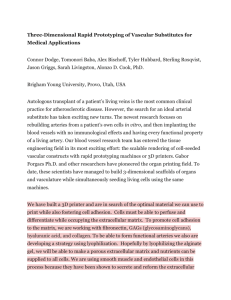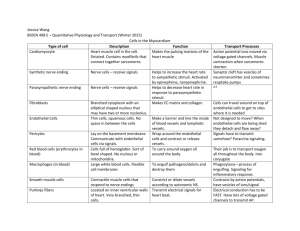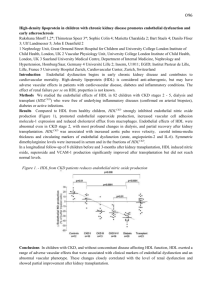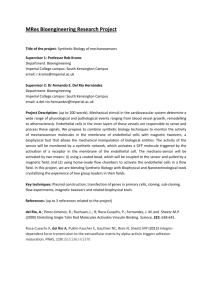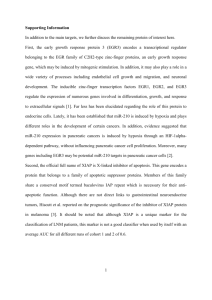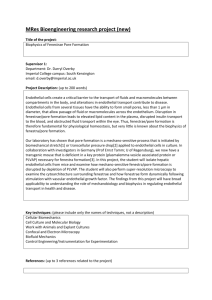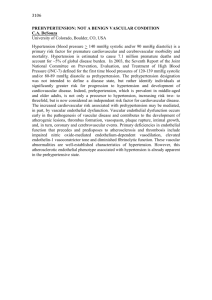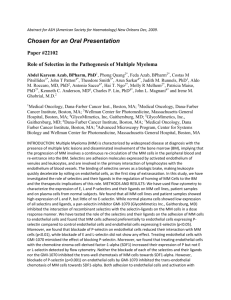Use of a New Double Layer Parallel
advertisement
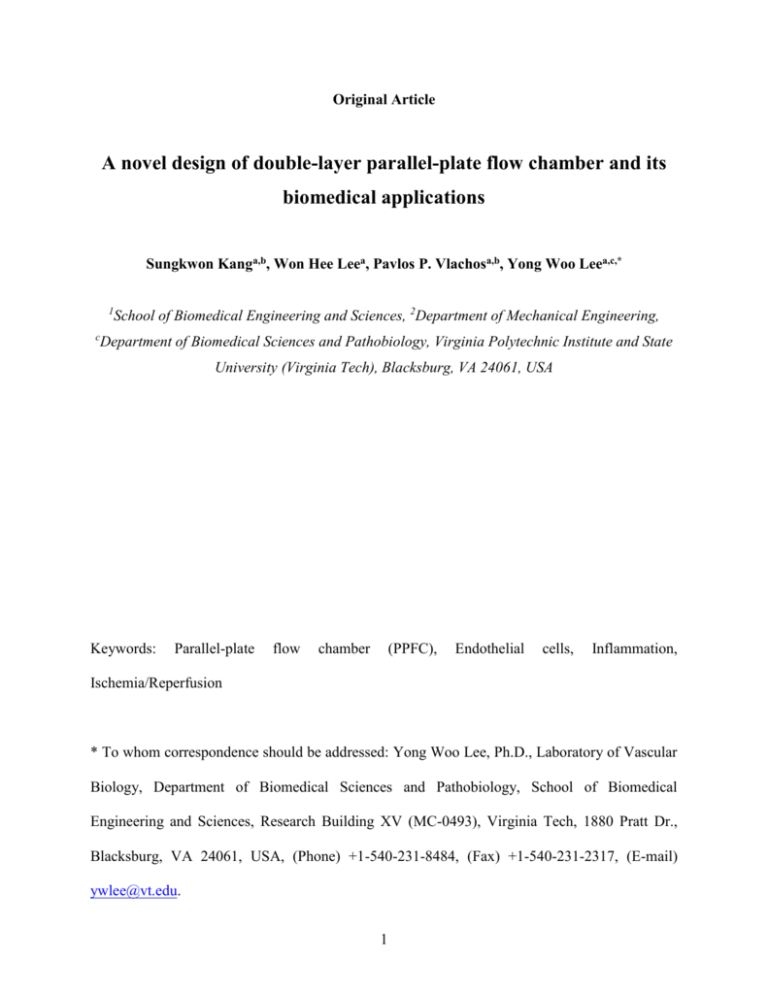
Original Article A novel design of double-layer parallel-plate flow chamber and its biomedical applications Sungkwon Kanga,b, Won Hee Leea, Pavlos P. Vlachosa,b, Yong Woo Leea,c,* 1 c School of Biomedical Engineering and Sciences, 2Department of Mechanical Engineering, Department of Biomedical Sciences and Pathobiology, Virginia Polytechnic Institute and State University (Virginia Tech), Blacksburg, VA 24061, USA Keywords: Parallel-plate flow chamber (PPFC), Endothelial cells, Inflammation, Ischemia/Reperfusion * To whom correspondence should be addressed: Yong Woo Lee, Ph.D., Laboratory of Vascular Biology, Department of Biomedical Sciences and Pathobiology, School of Biomedical Engineering and Sciences, Research Building XV (MC-0493), Virginia Tech, 1880 Pratt Dr., Blacksburg, VA 24061, USA, (Phone) +1-540-231-8484, (Fax) +1-540-231-2317, (E-mail) ywlee@vt.edu. 1 Abstract In the present study, we designed and constructed a novel double-layer parallel-plate flow chamber (PPFC). The multilayer design only requires 2D cutting, which is easier and faster to manufacture. It is also capable of accepting up to four glass slides facing each other so that the flow within the channel is exclusively formed by endothelial cells. Moreover, it minimizes the pressure loss across the chamber while maximizing the effective area of endothelial cells. Results from mathematical analysis and dye injection experiments indicated that a uniform magnitude of shear stress can be applied throughout the entire surface of endothelial cell monolayer. The present study also focused on testing whether a novel PPFC can be used to examine the effects of shear stress on the structure and function of endothelial cells. Rat brain microvascular endothelial cells (RBE4) and human microvascular endothelial cells (HMEC-1) were either maintained in static condition or exposed to laminar flow for 24 h. The morphological changes and attenuated expression of pro-inflammatory mediators were observed in endothelial cells exposed to the flow. In addition, RBE4 and HMEC-1 cells were either maintained in continuous laminar flow condition (Normal flow) or subjected to 1 h of flow cessation followed by reperfusion of flow (Ischemia/Reperfusion). The real-time RT-PCR analysis showed that ischemia/reperfusion markedly and significantly up-regulated expression of pro-inflammatory mediators, such as IL-6, ICAM-1, VCAM-1, and E-selectin, in endothelial cells. These data demonstrate that our newly designed PPFC can provide a better in vitro system for versatile applications of biomedical research. 2 Introduction The endothelium consists of a monolayer of vascular endothelial cells and lines the internal surface of the blood vessels. In normal physiological conditions, the vascular endothelium has been known to exert crucial roles in functionality and maintenance of the vessel walls by modulating vascular tone, providing a selective barrier for macromolecular permeability, and regulating blood flow (Ross, 1993; Sumpio et al., 2002; Fujiwara et al., 1998). On the other hand, activation or dysfunction of the vascular endothelium by a variety of pathophysiological stimuli has been implicated in the onset and progression of a number of human vascular diseases including cardiovascular disease, neurological disorders, and cancer metastasis (Ross, 1993; Lee and Hirani, 2006; de la Torre and Stefano, 2000; Choi et al., 2003). Since the vascular endothelium forms an interface between the blood and the underlying layers of the vessel walls, its unique location allows endothelial cells to be constantly exposed to the shear stress generated by blood flow. Numerous recent studies have demonstrated that vascular endothelial cells act as mechanoreceptors sensing and responding to shear stress. Indeed, endothelial cells are able to detect changes in mechanical forces using multiple sensing mechanisms and convert mechanical stimuli into intracellular signals. Then, shear stressmediated activation of signaling pathways subsequently triggers a variety of responses of endothelial cells that affect their structure and functions, such as endothelial cell proliferation, apoptosis, migration, permeability, and remodeling of cytoskeleton, as well as modulation of gene expression (Davies, 1995; Isenberg et al., 2006; Ando and Kamiya, 1996; Chien et al., 1998; Davies, 1984; Li et al., 2005). Even though the effects of shear stress on vascular endothelial cells have extensively been investigated, many difficulties arise in studying the in vivo responses of endothelium to shear stress due to the complex structures of the blood vessels and lack of resolution of the measurements with current technologies (Chung and Robertson, 2003; Helmlinger et al., 1991). To overcome such limitations of in vivo approaches as well as to study the dynamic response of vascular endothelial cells to controlled levels of fluid shear stress, various types of in vitro systems that allow cultured endothelial cells to be exposed to well-defined flow conditions have been developed. These systems include a cone-plate apparatus (Dewey et al., 1981), orbital shakers (Dardik et al., 2005), capillary flow tubes (Olesen et al., 1988; Jacobs et al., 1995), and 3 parallel-plate flow chambers (PPFC) (Usami et al., 1993; Ruel et al., 1995; Chiu et al., 1998; Brown and Larson, 2001; Lawrence et al., 1987). Among in vitro systems employed to study the effects of flow conditions on endothelial cells, PPFC have been the most commonly used to achieve a fully developed laminar flow within the channel of the chamber. A PPFC sets two plates in parallel to constitute a thin rectangular flow channel in between where a monolayer of cells is seeded on an either side. The simplicity of the concept and usage had evidently attributed to its wide spread. Consequently, a number of variant designs of PPFC have been developed for different applications of biomedical research such as platelet adhesion (Brown and Larson, 2001; Lawrence et al., 1987; Cao et al., 1997), cell morphology (Levesque and Nerem, 1985; Albuquerque et al., 2000; Gray et al., 2004), gene and protein expression (Miyaki et al., 2005; Peters et al., 2002; McCormick et al., 2000; Ando et al., 1995; Chiu et al., 1997; Morigi et al., 1995), and cell responses under special conditions (Ruel et al., 1995; Yee et al., 2006; Ivarsson et al., 1989; Chiu et al., 1998; Chen et al., 2006). These conventional PPFC, however, have shown weaknesses and problems in several aspects of its design. For example, the chambers are usually too difficult to handle and perform experiments which during the process erroneous outcomes may result. Indeed, the difficulty as well as the complexity in connecting tubes between the components of the system impede the progression of the experiment and evoke problems by either letting the cells stay outside the incubator for an extended period of time or causing considerable variations between each chamber. Setting up the chamber system bubble-free is also a difficult task with conventional PPFC that it often requires multiple trials to remove these bubbles. In addition, the success rate of the experiments are significantly lowered with unexpected crack on the glass slide which later can cause the media to leak and drain the reservoir connected to about three to four chambers. Furthermore, some designs are simply too difficult to manufacture which requires it to be fabricated by highly trained technicians and makes it inconvenient to implement further adjustments and improvements to the design to fully suit the researchers’ needs. In the present study, we designed and developed a new double-layer parallel-plate flow chamber (PPFC) to eliminate these problems and thus provide a better system that is easy to manufacture, simple to use, and convenient to adjust and improve upon its geometries. 4 Materials and Methods Parallel-plate flow chamber (PPFC) and flow loop apparatus The chamber consists of clear cast acrylic sheets (ACRYLITE, CYRO Industries, Rockaway, NJ) with two different thicknesses of 0.5-inch and 0.08-inch. The silicone sheets (Specialty Manufacturing Inc., Saginaw, MI) of 0.01-inch and 0.03-inch in thicknesses were used for gaskets. Binding head machine screws made of 18-8 stainless steel with thread size of 8-32-inch and length of 1-1/2-inch were held tight with 18-8 stainless steel hex nuts of 3/32-inch height that correspond to the same thread size as the screws. The inlets and outlets were formed with male slip polypropylene fittings (Cole-Parmer Instrument Co., Vernon Hills, IL) with 1/16-inch hose barb. Each acrylic layer of the chamber was cut off by Laser Computer Aided Modeling and Manufacture (LaserCAMM) machine. The system is a computerized, turn-key laser cutter that uses a laser beam to scribe or cut a wide variety of sheet materials into intricate patterns with a high degree of accuracy. In addition, since it integrates fully with Autodesk® AutoCAD®, any two-dimensional shape that is drawn on AutoCAD can be cut by LaserCAMM. More importantly, LaserCAMM rapidly creates accurate copies of a part which render numerous prototypes of different designs and can provide immediate feedback and help resolve manufacturing problems. The flow loop apparatus system which consists of upper and lower reservoirs providing a constant hydrostatic pressure was established as described previously (Frangos et al., 1988). The constant pressure head was maintained by continuously pumping the media from the lower reservoir to the upper reservoir by a peristaltic pump (Cole-Parmer) at rates faster than the flow through the chamber. The excess culture medium then overflowed down to the lower reservoir promoting gas exchange. Flow rate through the chamber was controlled with stopcocks installed on tubes leading into the inlets as the flow rates were monitored with flow meters connected from the outlets. 5 Cell cultures Rat brain microvascular endothelial cells (RBE4) were a generous gift from Dr. Michael Aschner (Vanderbilt University, Nashville, TN). RBE4 cells were cultured in 1:1 Ham’s F10MEM (Mediatech, Herndon, VA) supplemented with 10% fetal bovine serum (FBS), 100 U/ml penicillin, 100 μg/ml of streptomysin, 1 ng/ml of basic fibroblast growth factor (bFGF), 2 mM Lglutamine, and 12.5 mM HEPES (Mediatech). Human microvascular endothelial cells (HMEC1) were provided from Dr. Edwin Ades and Mr. Fransisco J. Candal of Center for Disease Control and Prevention (Atlanta, GA) and Dr. Thomas Lawley of Emory University (Atlanta, GA). HMEC-1 cells were cultured in MCDB 131 medium (Mediatech) enriched with 10% fetal bovine serum, 10 mM L-glutamine, 1% antibiotic-antimycotic, 1 μg/ml hydrocortisone (Sigma, St. Louis, MO), and 10 ng/ml epidermal growth factor (Roche, Indianapolis, IN). Both RBE4 and HMEC-1 cells were maintained in a humid 5% CO2 atmosphere at 37 °C. For flow experiments, endothelial cells were seeded on glass slides (38 mm × 75 mm, Fisher Scientific) coated with 0.025% Collagen Type I (BD Biosciences, Bedford, MA), and incubated for 5-7 days until they reach confluency. An inverted microscope equipped with 12-bit dynamics camera (The Axio Cam MR, Carl Zeiss Inc.) was used to observe morphological changes of endothelial cells in response to static and flow conditions. Real-time reverse transcriptase-polymerase chain reaction (RT-PCR) Total RNA was isolated and purified using RNeasy Mini Kit (Qiagen, Valencia, CA) according to the protocol of the manufacturer. 1 μg of total RNA was reverse-transcribed at 25 ºC for 15 min, 42 ºC for 45 min, and 99 ºC for 5 min in 20 μL of 5 mM MgCl2, 10 mM Tris-HCl, pH 9.0, 50 mM KCl, 0.1% Triton X-100, 1 mM dNTP, 1 unit/μL of recombinant RNasin ribonuclease inhibitor, 15 units/μg of AMV reverse transcriptase, and 0.5 μg of random hexamers. For quantitative PCR, amplifications of individual genes were performed on ABI 7300 Sequence Detection System (Applied Biosystems, Foster City, CA) using TaqMan® Universal PCR Master Mix, gene-specific TaqMan PCR probes and primers, and a standard thermal cycler protocol (50 ºC for 2 min before the 1st cycle, 95 ºC for 15 s, and 60 ºC for 1 min, repeated 45 times). For specific probes and primers of PCR amplifications, TaqMan® Gene 6 Expression Assay Reagents for rat interleukin-6 (IL-6) and glyceraldehyde-3-phosphate dehydrogenase (GAPDH), as well as human intercellular adhesion molecule-1 (ICAM-1), vascular cell adhesion molecule (VCAM-1), E-selectin, and -actin were obtained from Applied Biosystems. The threshold cycle (CT), which indicates the fractional cycle number at which the amount of amplified target gene reaches a fixed threshold, from each well was determined using by the Applied Biosystems Sequence Detection Software v1.2.3. Relative quantification, which represents the change in gene expression from real-time quantitative PCR experiments between static and flow-adapted groups as well as continuous and ischemia/reperfusion groups, was calculated by the comparative CT method as described earlier (Livak and Schmittgen, 2001; Deng et al., 2003). The data were analyzed using equation 2–ΔΔCT, where ΔΔCT = [CT of target gene - CT of housekeeping gene]flow-adapted or ischemia/reperfusion group – [CT of target gene - CT of housekeeping gene]static or continuous flow group. Evaluation of 2–ΔΔCT indicates the fold change in gene expression, normalized to a housekeeping gene (GAPDH or -actin) and relative to the control group. Statistical analysis Statistical analysis of data was completed using SigmaStat 3.5 (Systat Software, Inc., Point Richmond, CA). One-way ANOVA was used to compare mean responses among the treatments. For each endpoint, the treatment means was compared using Bonferroni least significant difference procedure. Differences among the means were considered significant at P < 0.05. Results and Discussion Design and construction of a novel double-layer parallel-plate flow chamber (PPFC) Flow through a PPFC is a steady and laminar stream of an incompressible and viscous Newtonian fluid. A schematic of the parallel plates is shown in Figure 1 with Cartesian coordinate system (x, y, z) defined within. Flow enters the parallel plates at the origin and exits where x equals the length of the chamber, l. The thin rectangular channel of a PPFC has a 7 constant cross-section where the ratio between the height, h, and the width, w, has a small value to assume infinite parallel plates. If we assume that all fluid particles are moving in the same direction, then the Navier-Stokes equations yields an exact solution (Fung, 1997). The solution with simple force balance leads us to the well known analytical estimation of the wall shear stress (WSS), wall , of a fully developed laminar flow through a rectangular channel to be wall 6Q , wh 2 (1) where is the dynamic fluid viscosity and Q is the volumetric flow rate (Nauman et al., 1999). Equation (1) implies that the WSS is proportional to volumetric flow rate and the fluid viscosity whereas inversely proportional to the width and the height of the channel. Since the fluid viscosity in a typical flow experiment remains constant, the width and height of the channel as well as the volumetric flow rate must be carefully chosen for the design of the experiment. Also because there is a limitation of how much of hydrostatic pressure can be applied within an incubator, the width and the height as well as the flow rate must be balanced with respect to each other to achieve the desired magnitude of WSS. In fact, a PPFC does not have infinitely long parallel plates. The fluid going through the inlets is disturbed and not fully developed. Furthermore, some of the surfaces of the parallel plates near the lateral walls experience a different magnitude of shear stress from the intended value. Thus the entrance length must be specified to ensure fully developed flow. For a Reynolds number lower than 100, the entrance length is given as (Fung, 1997) wh Le 1.3 . wh (2) The effect of the lateral walls can be visualized by plotting the velocity profile in a three dimensional space. The velocity field can be solved with a Fourier series expansion under no slip condition as v z* , y* 1 2 2 y *2 2 N n 1 1n cos 3 n * ny exp n z * 1 exp n z * 1 1 exp 2 n (3) where h w , n 2n 1 2 , and z* and y* are the normalized width and the height of the channel that range from -1 to 1 and 2 to 2 respectively (Panton, 2005). The value of 8 , or the lateral channel aspect ratio, typically ranges from 0.0033 (Chung et al., 2003) to 0.014 (Ruel et al., 1995). With the introduced parameters and equations, an active test region (ATR) can be defined to assure that an uniform shear stress is applied to the monolayer of endothelial cells (Chung et al., 2003). As Figure 2 schematically depicts the region of ATR, it excludes the parts where affected by the entrance, Le , and exit length, Lex , as well as the thickness of the boundary layer, Lw , generated by the lateral walls. Since exit lengths are typically shorter than the entrance lengths, we assume that it has the same length as Le for the symmetry of the design of the chamber. The boundary layer thickness Lw defines where the shear stress drops below 95% of the intended value. The design of the novel PPFC was aimed so that its basic geometries of the chamber are adjusted and manufactured without difficulty for different purposes and applications of biomedical research. The overall schematic of the chamber is shown in Figure 3A. In addition, special emphasis was placed on the design to facilitate the experimental processes by freeing from leakages, bubbles, and broken glass slides. Careful thoughts were taken into account to maximize the ATR with minimal space waste, ensure a uniform magnitude of shear stress throughout the entire endothelial cell monolayer, and thus avoid erroneous results. An important feature of the design is that the chamber consists of separate layers of different materials and thicknesses so that any new layer can be added or an existing layer be replaced in order to adapt a new research purpose. The design of the chamber is also capable of accepting up to four glass slides in series facing each other where the velocity profile of the flow is exclusively formed by the monolayers of endothelial cells. The design provides more opportunities for gene and protein expression analyses with a total of 96 cm2 endothelial cell monolayer per chamber. Placing glass slides in series shortens the duration of experiment by reducing the number chambers to be installed. Moreover, placing the glass slides on the top and bottom facing each other minimizes the pressure loss across the channel of the chamber. As depicted in Figure 3A, the chamber has a total of 7 layers of clear cast acrylic sheets and silicone gaskets. Layers (1) and (9) are the top and bottom of the chamber cut off from cast acrylic sheets of 0.5-inch thickness. The three ports on the left side of layer (1) serve as inlets where the middle one is for syringe access and the other two are connected to let the flow 9 through from a constant hydrostatic pressure head. The ports on the left side are two outlets. Layers (4) and (7) are cast acrylic sheets of 0.08-inch thickness which provide slots for the glass slides (3) and (6). Layers (2) and (8) are silicone gaskets of 0.03-inch thickness that serve as a firm grip for the glass slides that fit into the holes in the middle of the layers (4) and (7). These silicone gaskets also help render a flush surface for the disconnected gaps between the glass slides and the layers when the chamber is tightly closed. The smaller holes on each side of layer (2) serve as small reservoirs for fluid to stay before entering the thin slits of layer (4). The thin slits on each side of layer (4) distribute the flow evenly across the width of the channel. Layer (5) is a silicone gasket that constitutes the channel height h (Figure 1). The width of the hole of layer (5) is the width of the channel w (Figure 1) which is slightly shorter than the width of the glass slides to hold the gap between glass slides (3) and (6). Thus the flow channel is constituted between glass slides at layer (3) and (6) with the gasket at layer (5) in between as shown in Figure 3B. Only four of the glass slides (3) and (6) will have cells seeded and form the channel whereas the other four are plain glass slides placed to fill up the middle holes of layer (4) and (7). The chamber is closed tight with twelve stainless wing nuts (Figure 3C). To set up the chamber bubble free, the layers are installed in the order from (9) to (1) where the flow channel, reservoirs are filled up with media by means of syringe as each layer is piled up. In the present study, the geometries of the chamber were determined to perfuse a flow of moderately low WSS of 4 dyne/cm2 while having a sufficient amount of RNA samples for gene expression analysis using real-time reverse transcription-polymerase chain reaction (RT-PCR). The chosen thickness of the silicone gasket, or layer (5), for the channel height was 0.0254 cm where the width of the channel was to be 3.2cm on glass slides of 3.8 cm × 7.5 cm. This height and the width of the channel give a lateral channel aspect ratio of approximately 0.0078. The dynamic viscosity of the media for the endothelial cells was measured to be 0.72 cP. These values were then used to back solve the volumetric flow rate with equation (1). The average velocity through the channel gave a Reynolds number of 8.25. The estimated entrance length was 0.033 cm by equation (2), but instead of neglecting we chose the entrance length to be at 1 cm away from the thin slit on layer (3). The velocity profile through the channel of an aspect ratio of approximately 0.0078 was examined in three dimensions with equation (3) (Figure 4A). Figure 4B depicts the velocity profile seen from above the chamber, where the velocity is zero near the walls and stay at a 10 constant value throughout the most of the width of the channel. The place where the velocity drops below 95% from its maximum value found to be 0.027 cm away from the lateral walls. Since the length was negligible, we assumed that there were no boundary layers formed by the lateral walls. The flow inside the channel was visualized by means of dye injection to validate the design of the chamber. Figure 5 was produced by superimposing two separate photos taken with different needle positions in the sides of the chamber. The dye was injected from the channel-like reservoir before the thin slits. The streamlines on the top and the bottom passed near the wall where the middle three lines were placed evenly in the middle of the channel. The streamlines near the lateral walls were not disturbed ensuring that the lateral wall effects are negligible. This data from mathematical analysis of the geometry (Figure 4) and dye injection experiments through the novel PPFC (Figure 5) provide clear evidence that a uniform magnitude of shear stress can be applied throughout the entire surface of endothelial cell monolayer. Validation of a novel double-layer PPFC for biomedical research applications To validate whether a novel PPFC can be employed for studies in the areas of biomedical research, the effects of fluid shear stress on the structure and function of endothelial cells were examined. In the present study, we used two different cell types, such as rat brain microvascular endothelial cells (RBE4) and human microvascular endothelial cells (HMEC-1), which are representative of both central and peripheral microvascular systems. RBE4 cells were derived from rat brain microvascular endothelial cells immortalized with the plasmid pE1A-neo containing the E1A region of adenovirus 2 and a neomycin resistance gene. RBE4 cells have been widely used as an experimental model to study the brain microvasculature in vitro because they are known to preserve many features of the in vivo brain microvascular endothelium (Yang et al., 2001; Yang and Aschner, 2003). HMEC-1 cells are an immortalized cell line obtained by transformation of human dermal microvascular endothelial cells with the SV40 large T antigen. It has been generally believed that these cells retain endothelial cell phenotype and functional characteristics and provide the best physiological cell model in research related to the peripheral microvascular endothelium (True et al., 2000; Eum et al., 2004; Eum et al., 2006; Lee et al., 2003). 11 Effects of fluid shear stress on morphological responses of endothelial cells. It is widely believed that the reorganization of the endothelial cell morphology is one of the earliest responses in vascular endothelial cells that are exposed to fluid shear stress. Previous in vivo and in vitro studies have demonstrated the elongation and alignment of endothelial cells parallel to the direction of flow (Topper and Gimbrone, 1999; Fujiwara et al., 1998; Davies, 1995; Dewey et al., 1981; Isenberg et al., 2006; Li et al., 2005). In the present study, we first examined the morphological changes of endothelial cells associated with exposure to physiologically relevant shear stress using a novel PPFC. Rat brain microvascular endothelial cells (RBE4) and human microvascular endothelial cells (HMEC-1) were either maintained in static condition or exposed to laminar flow at a shear stress of 4 dyne/cm2 for 24 h. As shown in Figure 6, fluid shear stress induced dramatic morphological changes such as cell elongation and alignment with the direction of flow (lower panels). In contrast, endothelial cells in static condition appeared to be round shape and no significant cell orientation was observed (upper panels). These results on cell shape and orientation are consistent with those reported previously by other groups (Dewey, et al., 1981; Eskin et al., 1984; Levesque and Nerem, 1985; Chiu et al., 1998; Fujiwara et al., 1998; Topper and Gimbrone, 1999; Li et al., 2005; Davies, 1995). Effects of fluid shear stress on inflammatory gene expression of endothelial cells. Shear stressmediated signaling pathways have been known to trigger endothelial cell responses and contribute to the pathophysiology of human vascular diseases. For example, changes in shear stress resulting from altered blood flow play a crucial role in the development of cardiovascular diseases by regulating inflammatory reactions in the vascular endothelium (Li et al., 2005; Davies, 1995). Previous studies have demonstrated that inflammatory responses in the vascular endothelium are primarily regulated through the production of pro-inflammatory mediators (Ross, 1993; Ross, 1999; Lee et al., 2004a; Lee et al., 2004b; Lee et al., 2006). In fact, enhanced expression of pro-inflammatory cytokines (e.g., IL-6) and adhesion molecules (e.g., ICAM-1, VCAM-1 and E-selectin) in vascular endothelial cells and their close interactions facilitate recruiting and adhering inflammatory cells into the vessel wall, and thus stimulate transendothelial migration, which can be considered one of the earliest events in the progression of human vascular diseases. In the present study, expression levels of pro-inflammatory cytokine 12 and adhesion molecules were determined by quantitative real-time RT-PCR to examine the effects of fluid shear stress on inflammatory responses in vascular endothelium. A significant upregulation of cytokine IL-6 (Figure 7A) and adhesion molecules ICAM-1, VCAM-1 and Eselectin (Figure 7B) was observed in microvascular endothelial cells which were exposed to laminar flow at a shear stress of 4 dyne/cm2 (Flow) for 24 h, compared with those maintained in static condition (Static). These findings are in agreement with numerous previous studies suggesting that normal, healthy shear stress can influence the ability of vascular endothelium to carry out many of its beneficial functions in health including anti-inflammatory effects (Topper and Gimbrone, 1999; Li et al., 2005; Ando et al., 1995; Albuquerque et al., 2000). Effects of ischemia/reperfusion on inflammatory gene expression of endothelial cells. It has become evident that the cessation of blood flow (ischemia) causes tissue damage and the restoration of blood flow (reperfusion) produces even more additional injuries to a wide variety of tissues. Indeed, ischemia/reperfusion injury occurs in a broad spectrum of pathological outcomes in patients after organ transplantation and cardiovascular surgery as well as myocardial infarction and stroke (Khalil et al., 2006). Compelling body of evidence has indicated that ischemia/reperfusion injury is closely associated with inflammatory reactions in vascular endothelium. For example, Krizanac-Bengez et al. (2006) showed that exposure of a dynamic in vitro blood-brain barrier (BBB) model to flow cessation/reperfusion resulted in an acute release of pro-inflammatory cytokines, such as TNF- and IL-6, and disruptions of BBB integrity. It was also found that myocardial ischemia/reperfusion injury is related to an inflammatory response though attachment of polymorphonuclear leukocytes (PMNs) to the vascular endothelium with subsequent infiltration into the damaged myocardium (Hansen, 1995; Onai et al., 2003). Previous studies from both in vivo and in vitro experimental models have revealed that transendothelial migration of blood leukocytes into tissues is mediated primarily by adhesion molecules, such as E-selectin, ICAM-1, and VCAM-1, which are overexpressed on the surface of vascular endothelium in response to ischemia/reperfusion injury (Cassie et al., 2004; Billups et al., 1995; Fleming et al., 2003; Wang et al., 1998). The crucial role for adhesion molecules in ischemia/reperfusion-mediated inflammatory reactions and subsequent tissue injury has been further confirmed in a variety of animal models of ischemia/reperfusion by blocking these molecules through antagonist and monoclonal antibody treatments, genetic deletion, and 13 exposure to antisense oligonucleotides (Onai et al., 2003; Kurose et al., 1994; Winn et al., 1993; Wang et al., 1998; Connolly et al., 1996; Toda et al., 2000). In the present study, we examined the effects of ischemia/reperfusion on pro-inflammatory pathways in microvascular endothelial cells. Briefly, cells were exposed to laminar flow at a shear stress of 4 dyne/cm2 for 24 h. Flowadapted endothelial cells were then either maintained in continuous laminar flow condition (4 dyne/cm2) (Normal Flow) or subjected to 1 h of flow cessation followed by reperfusion with laminar flow (4 dyne/cm2) (Ischemia/Reperfusion). In consistent with previous studies, ischemia/reperfusion markedly and significantly up-regulated expression of pro-inflammatory cytokine IL-6 (Figure 8A) and adhesion molecules ICAM-1, VCAM-1, and E-selectin (Figure 8B). These data provide robust evidence that a novel PPFC can be used as an effective in vitro system to mimic ischemia/reperfusion injury in vivo. Acknowledgments This work was supported by SBES Seed Grant from Virginia Tech-Wake Forest University. 14 References Albuquerque, M.L., Waters, C.M., Savla, U., Schnaper, H.W., Flozak, A.S., 2000. Shear stress enhances human endothelial cell wound closure in vitro. American Journal of Physiology Heart and Circulatory Physiology 279, H293-H302. Ando, J., Kamiya, A., 1996. Flow-dependent regulation of gene expression in vascular endothelial cells. Japanese Heart Journal 37, 19-32. Ando, J., Tsuboi, H., Korenaga, R., Takada, Y., Toyama-Sorimachi, N., Miyasaka, M., Kamiya, A., 1995. Down-regulation of vascular adhesion molecule-1 by fluid shear stress in cultured mouse endothelial cells. Annals of the New York Academy of Sciences 748, 148-156. Billups, K.L., Palladino, M.A., Hinton, B.T., Sherley, J.L., 1995. Expression of E-selectin mRNA during ischemia/reperfusion injury. Journal of Laboratory and Clinical Medicine 125, 626-633. Cao, J., Usami, S., Dong, C., 1997. Development of a side-view chamber for studying cellsurface adhesion under flow conditions. Annals of Biomedical Engineering 25, 573-580. Cassie, S., Masterson, M.F., Polukoshko, A., Viskovic, M.M., Tibbles, L.A., 2004. Ischemia/reperfusion induces the recruitment of leukocytes from whole blood under flow conditions. Free Radical Biology & Medicine 36, 1102-1111. Chen, C.N., Chang, S.F., Lee, P.L., Chang, K., Chen, L.J., Usami, S., Chien, S., Chiu, J.J., 2006. Neutrophils, lymphocytes, and monocytes exhibit diverse behaviors in transendothelial and subendothelial migrations under coculture with smooth muscle cells in disturbed flow. Blood 107, 1933-1942. Chien, S., Li, S., Shyy, Y.J., 1998. Effects of mechanical forces on signal transduction and gene expression in endothelial cells. Hypertension 31, 162-169. Chiu, J.J., Wang, D.L., Chien, S., Skalak, R., Usami, S., 1998. Effects of disturbed flow on endothelial cells. Journal of Biomechanical Engineering 120, 2-8. Chiu, J.J., Wung, B.S., Shyy, J.Y., Hsieh, H.J., Wang, D.L., 1997. Reactive oxygen species are involved in shear stress-induced intercellular adhesion molecule-1 expression in endothelial cells. Arteriosclerosis, Thrombosis, and Vascular Biology 17, 3570-3577. Choi, W., Eum, S.Y., Lee, Y.W., Hennig, B., Robertson, L.W., Toborek, M., 2003. PCB 104induced proinflammatory reactions in human vascular endothelial cells: Relationship to cancer metastasis and atherogenesis. Toxicological Sciences 75, 47-56. Chung, B.J., Robertson, A.M., Peters, D.G., 2003. The numerical design of a parallel plate flow chamber for investigation of endothelial cell response to shear stress. Computers & Structures 81, 535-546. Connolly, E.S. Jr., Winfree, C.J., Springer, T.A., Naka, Y., Liao, H., Yan, S.D., Stern, D.M., Solomon, R.A., Gutierrez-Ramos, J.C., Pinsky, D.J., 1996. Cerebral protection in homozygous null ICAM-1 mice after middle cerebral artery occlusion: role of neutrophil adhesion in the pathogenesis of stroke. Journal of Clinical Investigation 97, 209-216. Dardik, A., Chen, L., Frattini, J., Asada, H., Aziz, F., Kudo, F.A., Sumpio, B.E., 2005. Differential effects of orbital and laminar shear stress on endothelial cells. Journal of Vascular Surgery 41, 869-880. Davies, P. F., 1995. Flow-mediated endothelial mechanotransduction. Physiological Reviews 75, 519-560. 15 Davies, P.F., Dewey, C.F., Jr., Bussolari, S.R., Gordon, E.J., Gimbrone, M.A., Jr., 1984. Influence of hemodynamic forces on vascular endothelial function. In vitro studies of shear stress and pinocytosis in bovine aortic cells. Journal of Clinical Investigation 73, 1121-1129. de la Torre, J.C., Stefano, G.B., 2000. Evidence that Alzheimer’s disease is a microvascular disorder: the role of constitutive nitric oxide. Brain Research Reviews 34, 119-136. Deng, X., Li, H., Tang, Y.W., 2003. Cytokine expression in respiratory syncytial virus-infected mice as measured by quantitative reverse-transcriptase PCR. Journal of Virological Methods 107, 141-146. Dewey, C.F., Jr., Bussolari, S.R., Gimbrone, M.A., Jr., Davies, P.F., 1981. The dynamic response of vascular endothelial cells to fluid shear stress. Journal of Biomechanical Engineering 103, 177-185. Eskin, S.G., Ives, C.L., McIntire, L.V., Navarro, L.T., 1984. Response of cultured endothelial cells to steady flow. Microvascular Research 28, 87-94. Eum, S.Y., Lee, Y.W., Hennig, B., Toborek, M., 2004. VEGF regulates PCB 104-mediated stimulation of permeability and transmigration of breast cancer cells in human microvascular endothelial cells. Experimental Cell Research 296, 231-244. Eum, S.Y., Lee, Y.W., Hennig, B., Toborek, M., 2006. The interplay between epidermal growth factor receptor and Janus kinase 3 regulates polychlorinated biphenyl-induced matrix metalloproteinase-3 expression and transendothelial migration of tumor cells. Molecular Cancer Research 4, 361-370. Fleming, S.D., Anderson, J, Wilson, F., Shea-Donohue, T., Tsokos, G.C., 2003. C5 is required for CD49d expression on neutrophils and VCAM expression on vascular endothelial cells following mesenteric ischemia/reperfusion. Clinical Immunology 106, 55-64. Frangos, J.A., Mcintire, L.V., Eskin, S.G., 1988. Shear-stress induced stimulation of mammalian cell metabolism. Biotechnology and Bioengineering 32, 1053-1060. Fujiwara, K., Masuda, M., Osawa, M., Katoh, K., Kano, Y., Harada, N., Lopes, R.B., 1998. Response of vascular endothelial cells to fluid flow. Biological Bulletin, 194, 384-385. Fung, Y.C., 1997. Biomechanics: Circulation, Springer, NY, p. 302. Gray, D.S., Tan, J.L., Voldman, J., Chen, C.S., 2004. Dielectrophoretic registration of living cells to a microelectrode array. Biosensors and Bioelectronics 19, 1765-1774. Hansen, P.R., 1995. Role of neutrophils in myocardial ischemia and reperfusion. Circulation 91, 1872-1885. Helmlinger, G., Geiger, R.V., Schreck, S., Nerem, R.M., 1991. Effects of pulsatile flow on cultured vascular endothelial cell morphology. Journal of Biomechanical Engineering 113, 123-131. Isenberg, B.C., Williams, C., Tranquillo, R.T., 2006. Endothelialization and flow conditioning of fibrin-based media-equivalents. Annals of Biomedical Engineering 34, 971-985. Ivarsson, B.L., Cambria, R.P., Megerman, J., Abbott, W.M., 1989. Fibronectin enhances early shear stress resistance of seeded adult human venous endothelial cells. Journal of Surgical Research 47, 203-207. Jacobs, E.R., Cheliakine, C., Gebremedhin, D., Birks, E.K., Davies, P.F., Harder, D.R., 1995. Shear activated channels in cell-attached patches of cultured bovine aortic endothelial cells. Pflugers Arch 431, 129-131. Khalil, A.A., Aziz, F.A., Hall, J.C., 2006. Reperfusion injury. Plastic and Reconstructive Surgery 117, 1024-1033. 16 Krizanac-Bengez, L., Mayberg, M.R., Cunningham, E., Hossain, M., Ponnampalam, S., Parkinson, F.E., Janigro, D., 2006. Loss of shear stress induces leukocyte-mediated cytokine release and blood-brain barrier failure in dynamic in vitro blood-brain barrier model. Journal of Cellular Physiology 206, 68-77. Kurose, I., Anderson, D.C., Miyasaka, M., Tamatani, T., Paulson, J.C., Todd, R.F., Rusche, J.R., Granger, D.N., 1994. Molecular determinants of reperfusion-induced leukocyte adhesion and vascular protein leakage. Circulation Research 74, 336-343. Lawrence, M.B., McIntire, L.V., Eskin, S.G., 1987. Effect of flow on polymorphonuclear leukocyte/endothelial cell adhesion. Blood 70, 1284-1290. Lee, Y.W., Eum, S.Y., Chen, K.C., Hennig, B., Toborek, M., 2004a. Gene expression profile in interleukin-4-stimulated human vascular endothelial cells. Molecular Medicine 10, 19-27. Lee, Y.W., Eum, S.Y., Nath, A., Toborek, M., 2004b. Estrogen-mediated protection against HIV Tat protein-induced inflammatory pathways in human vascular endothelial cells. Cardiovascular Research 63, 139-148. Lee, Y.W., Hirani A.A., 2006. Role of interleukin-4 in atherosclerosis. Archives of Pharmacal Research 29, 1-15. Lee, Y.W., Park, H.J., Son, K.W., Hennig, B., Robertson, L.W., Toborek, M., 2003. 2,2’,4,6,6’Pentachlorobiphenyl (PCB104) induces apoptosis of human microvascular endothelial cells through the caspase-dependent activation of CREB. Toxicology and Applied Pharmacology 189, 1-10. Levesque, M.J., Nerem, R.M., 1985. The elongation and orientation of cultured endothelial cells in response to shear stress. Journal of Biomechanical Engineering 107, 341-347. Li, Y.J., Haga J.H., Chien, S., 2005. Molecular basis of the effects of shear stress on vascular endothelial cells. Journal of Biomechanics 38, 1949-1971. Livak, K.J., Schmittgen, T.D., 2001. Analysis of relative gene expression data using real-time quantitative PCR and the 2–ΔΔCT method. Methods 25, 402-408. McCormick, S.M., Whitson, P.A., Wu, K.K., McIntire, L.V., 2000. Shear stress differentially regulates PGHS-1 and PGHS-2 protein levels in human endothelial cells. Annals of Biomedical Engineering 28, 824-833. Miyagi, M., Miwa, Y., Takahashi-Yanaga, F., Morimoto, S., and Sasaguri, T., 2005. Activator protein-1 mediates shear stress-induced prostaglandin d synthase gene expression in vascular endothelial cells. Arteriosclerosis, Thrombosis, and Vascular Biology 25, 970-975. Morigi, M., Zoja, C., Figliuzzi, M., Foppolo, M., Micheletti, G., Bontempelli, M., Saronni, M., Remuzzi, G., Remuzzi, A., 1995. Fluid shear stress modulates surface expression of adhesion molecules by endothelial cells. Blood 85, 1696-1703. Nauman, E.A., Risic, K.J., Keaveny, T.M., Satcher, R.L., 1999. Quantitative assessment of steady and pulsatile flow fields in a parallel plate flow chamber. Annals of Biomedical Engineering 27, 194-199. Nevesque, M.J., Nerem, R.M., 1985. The elongation and orientation of cultured endothelial cells in response to shear stress. ASME Journal of Biomechanical Engineering 107, 341-347. Olesen, S.P., Clapham, D.E., Davies, P.F., 1988. Haemodynamic shear stress activates a K+ current in vascular endothelial cells. Nature 331, 168-170. Onai, Y., Suzuki, J., Nishiwaki, Y., Gotoh, R., Berens, K., Dixon, R., Yoshida, M., Ito, H., Isobe, M., 2003. Blockade of cell adhesion by a small molecule selectin antagonist attenuates myocardial ischemia/reperfusion injury. European Journal of Pharmacology 481, 217-225. Panton, R.L., 2005. Incompressible flow. John Wiley & Sons, Inc., Hoboken, NJ, pp. 213-216. 17 Peters, D.G., Zhang, X.C., Benos, P.V., Heidrich-O'Hare, E., Ferrell, R.E., 2002. Genomic analysis of immediate/early response to shear stress in human coronary artery endothelial cells. Physiological Genomics 12, 25-33. Ross, R., 1993. The pathogenesis of atherosclerosis: a perspective for the 1990s. Nature 362, 801-809. Ross, R., 1999. Atherosclerosis is an inflammatory disease. American Heart Journal 138, S419S420. Ruel, J., Lemay, J., Dumas, G., Doillon, C., Charara, J., 1995. Development of a parallel plate flow chamber for studying cell behavior under pulsatile flow. ASAIO Journal 41, 876-883. Sumpio, B.E., Riley, J.T., Dardik, A., 2002. Cells in focus: endothelial cell. The International Journal of Biochemistry and Cell Biology 34, 1508-1512. Toda, K., Kayano, K., Karimova, A., Naka, Y., Fujita, T., Minamoto, K., Wang, C.Y., Pinsky, D.J., 2000. Antisense intercellular adhesion molecule-1 (ICAM-1) oligodeoxyribonucleotide delivered during organ preservation inhibits posttransplant ICAM-1 expression and reduces primary lung isograft failure. Circulation Research 86, 166-174. Topper, J.N., Gimbrone, M.A., Jr., 1999. Blood flow and vascular gene expression: fluid shear stress as a modulator of endothelial phenotype. Molecular Medicine Today 5, 40-46. True, A.L., Rahman, A., Malik, A.B., 2000. Activation of NF-B induced by H2O2 and TNF- and its effects on ICAM-1 expression in endothelial cells. American Journal of Physiology – Lung Cellular and Molecular Physiology 279, L302-L311. Wang, C.Y., Naka, Y., Liao, H., Oz, M.C., Springer, T.A., Gutierrez-Ramos, J.C., Pinsky, D.J., 1998. Cardiac graft intercellular adhesion molecule-1 (ICAM-1) and interleukin-1 expression mediate primary isograft failure and induction of ICAM-1 in organs remote from the site of transplantation. Circulation Research 82, 762-772. Winn, R.K., Liggitt, D., Vedder, N.B., Paulson, J.C., Harlan, J.M., 1993. Anti-P-selectin monoclonal antibody attenuates reperfusion injury to the rabbit ear. Journal of Clinical Investigation 92, 2042-2047. Yang J., Aschner M., 2003. Developmental aspects of blood-brain barrier (BBB) and rat brain endothelial (RBE4) cells as in vitro model for studies on chlorpyrifos transport. Neurotoxicology 24, 741-745. Yang J., Mutkus L.A., Sumner D., Stevens J.T., Eldridge J.C., Strandhoy J.W., Aschner M., 2001. Transendothelial permeability of chlorpyrifos in RBE4 monolayers is modulated by astrocyte-conditioned medium. Molecular Brain Research 16, 43-50. Yee, A., Sakurai, Y., Eskin, S.G., McIntire, L.V., 2006. A validated system for simulating common carotid arterial flow in vitro: alteration of endothelial cell response. Annals of Biomedical Engineering 34, 593-604. 18 Figure Legends Figure 1. Schematic diagram of the three-dimensional Cartesian coordinate system (x, y, z) of a novel double-layer parallel-plate flow chamber (PPFC). The fluid enters the gap of height h between the parallel plates where x is at the origin, flows through a channel with a constant cross-section, and exits where x equals the length of the chamber, l. Figure 2. Schematic diagram of an active test region (ATR) of a novel double-layer parallelplate flow chamber (PPFC). The ATR excludes the regions where affected by the entrance length ( Le ) and exit length ( Lex ), as well as the thickness of the boundary layer ( Lw ) generated by the lateral walls. The ATR defined the boundaries where the shear stress drops below 95% of the maximum value, which typically keep almost constant in the middle section. Most of the area of endothelial cell monolayer is to be placed within these limits defined by ATR unless either of the lengths is considered to be insignificant or negligible. Figure 3. The basic design of a novel double-layer parallel-plate flow chamber (PPFC). (A) The chamber has a total of seven layers including five clear cast acrylic sheets and two silicone gaskets. Layers (1) and (9) are the top and bottom of the chamber cut off from 0.5”-thick cast acrylic sheets. The three ports on the right side of layer (1) serve as inlets where the middle one is for syringe access and the other two are connected to let the flow through from a constant hydrostatic pressure head. The ports on the left side of layer (1) are two outlets. Two ports of inlets and outlets are designed symmetrically to provide a more uniform flow through a wide width of the chamber. Layers (2) and (8) are silicone gaskets of 0.03” thickness and serve as a firm grip for the glass slides (3) and (6). Layers (4) and (7) are cast acrylic sheets of 0.08” thickness which provide slots for the glass slides. Layer (5) is a silicone gasket of 0.01” thickness that constitutes the gap between the glass slides. (B) The flow channel is constituted between glass slides (3) and (6) with the gasket layer (5). (C) Schematic diagram of fully assembled novel double-layer PPFC. 19 Figure 4. Mathematical analysis of the geometry of a novel double-layer parallel-plate flow chamber (PPFC). (A) The three-dimensional velocity profile. (B) The velocity profile from above or y direction. Figure 5. The visualized fluid flow profile through the channel of a novel double-layer parallelplate flow chamber (PPFC). Figure 6. Fluid shear stress causes morphological changes in microvascular endothelial cells. Rat brain microvascular endothelial cells (RBE4; left panels) and human microvascular endothelial cells (HMEC-1; right panels) were maintained in static condition (upper panels) or exposed to laminar flow at a shear stress of 4 dyne/cm2 (lower panels). Following incubation for 24 h, morphological changes of endothelial cells in response to static and flow conditions were visualized as described in Materials and Methods. Figure 7. Fluid shear stress attenuates expression of pro-inflammatory mediators in microvascular endothelial cells. Rat brain microvascular endothelial cells (RBE4) and human microvascular endothelial cells (HMEC-1) were maintained in static condition (Static) or exposed to laminar flow at a shear stress of 4 dyne/cm2 (Flow) for 24 h. Expression levels of proinflammatory mediators, such as IL-6 (A) and adhesion molecules (ICAM-1, VCAM-1, and Eselectin) (B), were determined by quantitative real-time RT-PCR as described in Materials and Methods. Data are means ± SEM of 4 determinations. *Statistically significant compared with the static condition (P < 0.05). Figure 8. Ischemia/reperfusion up-regulates expression of pro-inflammatory mediators in microvascular endothelial cells. Rat brain microvascular endothelial cells (RBE4) and human microvascular endothelial cells (HMEC-1) were exposed to laminar flow at a shear stress of 4 dyne/cm2 for 24 h. Flow-adapted microvascular endothelial cells were either maintained in continuous laminar flow condition (4 dyne/cm2) for 25 h (A) and 13 h (B) (Normal Flow) or subjected to 1 h of flow cessation followed by reperfusion with laminar flow (4 dyne/cm2) for 24 h (A) and 12 h (B) (Ischemia/Reperfusion). Expression levels of pro-inflammatory mediators, such as IL-6 (A) and adhesion molecules (ICAM-1, VCAM-1, and E-selectin) (B), were 20 determined by quantitative real-time RT-PCR as described in Materials and Methods. Data are means ± SEM of 4 determinations. *Statistically significant compared with the static condition (P < 0.05). 21
